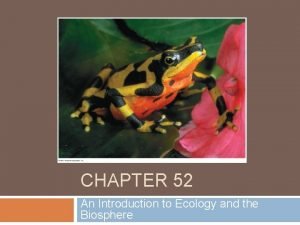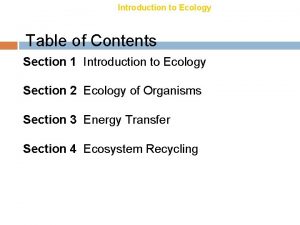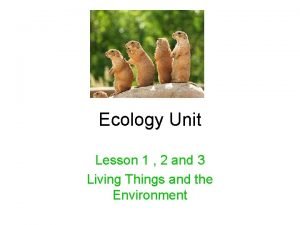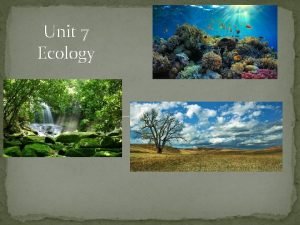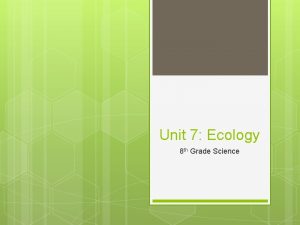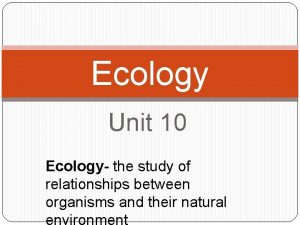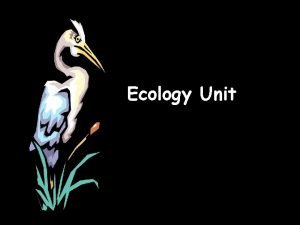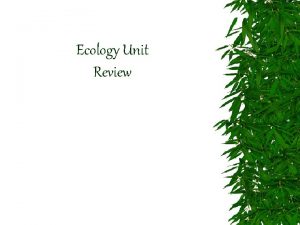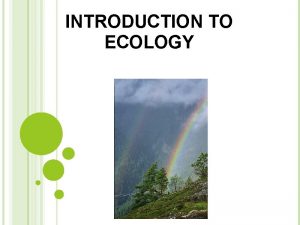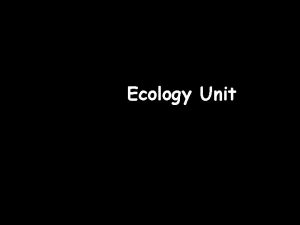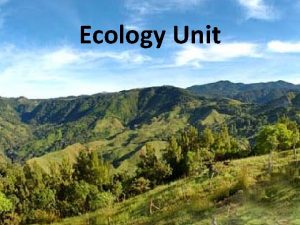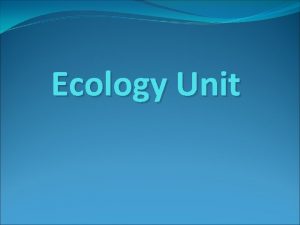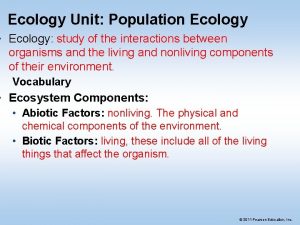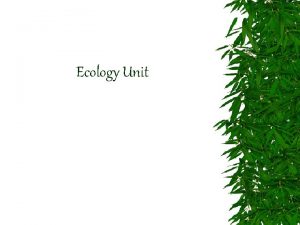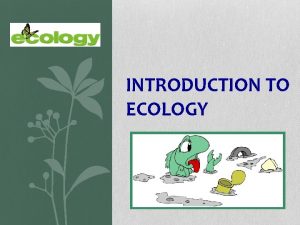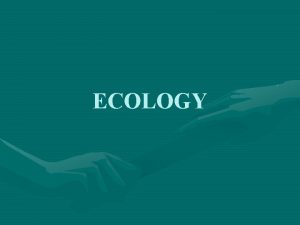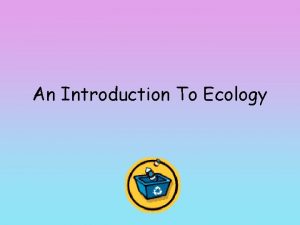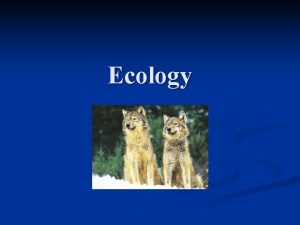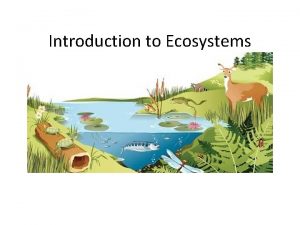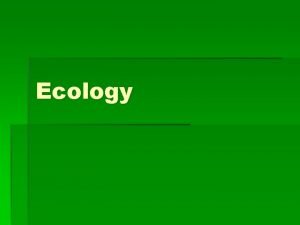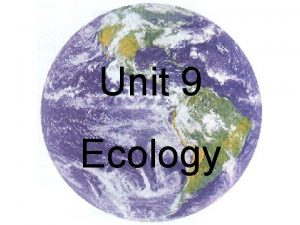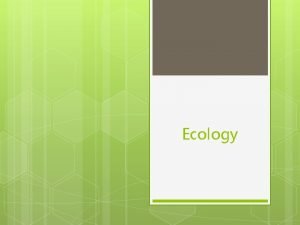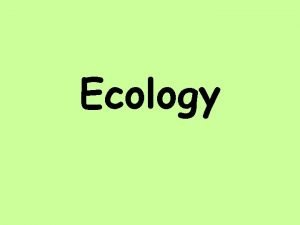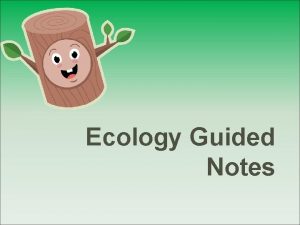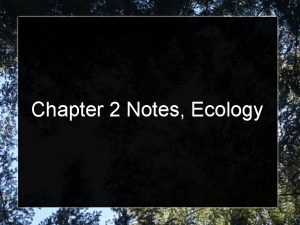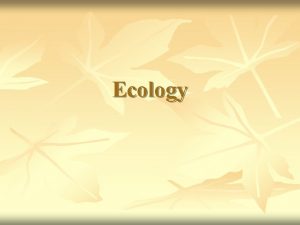INTRODUCTION TO THE ECOLOGY UNIT WHAT IS ECOLOGY

























- Slides: 25

INTRODUCTION TO THE ECOLOGY UNIT

WHAT IS ECOLOGY? • Ecology (Def. ): The study of interactions that take place between organisms and their environment

• Organism (def. ) – An individual living (ONE) thing

What are the characteristics of an organism (living things)?

• All living things have an organized structure: composed of one or more cells.

• All living things need energy

All living things reproduce.

All living things grow and develop.

All living things adjust to changes in the environment. • Ex. Trees adjust to cold, dry winter weather by losing their leaves.

Living things adapt and evolve.

• Review: What does bio- mean? • Biotic (Def. ) Factors: Are all the living parts of the environment. • Example: Animals, plants, bacteria • The prefix ‘a-’ means opposite of • Abiotic (Def. ) Factors: Are all the non -living parts of the environment. • Example: Dirt, Rock, Water, Air

• Habitat (def. ): a place where an organism lives out its life • Ex: lawn, bottom of a stream, forest, pond • Niche (def. ): strategies and adaptations a species uses in its environments – how it meets its specific needs for food and shelter, how and where it survives, and where it reproduces


• Population- a group of individuals of a single species that occupy the same general area. • Community-interacting populations that live in the same area. • Ecosystem- made of 1 or more communities; an environment of biotic and abiotic factors. • Biosphere: ALL ecosystems put together

POPULATION

WE ARE A POPULATION TOO SCHURZ POPULATION

COMMUNITY

ECOSYSTEM

BIOSPHERE

POSTER Organism Population Community Ecosystem

POPULATION DYNAMICS (WHAT SHAPES & CHANGES THE POPULATION) • Characteristics of Dynamics • Size • Immigration • Emigration • Births • Deaths • Survivorship

• What can cause a population to decline?

LIMITING FACTOR • Anything that restricts the number of individuals in a population. • Includes biotic (living) and abiotic (nonliving) features of the ecosystem

POPULATION SIZE IS LIMITED BY: DENSITY-DEPENDENT DENSITY-INDEPENDENT FACTOR • • • Disease Competition Predators Parasites Food Crowding (space) • • • The greater the population, the greater effect these factors have. Most are BIOTIC factors Volcanic eruptions Temperature Storms Floods Drought Flooding are ABIOTIC factors

• What kind of factor do you think influenced the deaths of these cows? • Was it density-dependent or Independent? Explain.
 Unit 6 review questions
Unit 6 review questions Chapter 52: an introduction to ecology and the biosphere
Chapter 52: an introduction to ecology and the biosphere Chaparral climograph
Chaparral climograph Section 18-1 introduction to ecology worksheet answers
Section 18-1 introduction to ecology worksheet answers Lesson 1: introduction to ecology answer key
Lesson 1: introduction to ecology answer key Unit 7 ecology answer key
Unit 7 ecology answer key Unit 7 ecology answer key
Unit 7 ecology answer key Unit 5 ecology
Unit 5 ecology Biological magnification
Biological magnification Ecology unit review
Ecology unit review Sulfur oxide
Sulfur oxide Hình ảnh bộ gõ cơ thể búng tay
Hình ảnh bộ gõ cơ thể búng tay Frameset trong html5
Frameset trong html5 Bổ thể
Bổ thể Tỉ lệ cơ thể trẻ em
Tỉ lệ cơ thể trẻ em Chó sói
Chó sói Chụp tư thế worms-breton
Chụp tư thế worms-breton Chúa sống lại
Chúa sống lại Kể tên các môn thể thao
Kể tên các môn thể thao Thế nào là hệ số cao nhất
Thế nào là hệ số cao nhất Các châu lục và đại dương trên thế giới
Các châu lục và đại dương trên thế giới Công của trọng lực
Công của trọng lực Trời xanh đây là của chúng ta thể thơ
Trời xanh đây là của chúng ta thể thơ Mật thư tọa độ 5x5
Mật thư tọa độ 5x5 Làm thế nào để 102-1=99
Làm thế nào để 102-1=99 Phản ứng thế ankan
Phản ứng thế ankan


